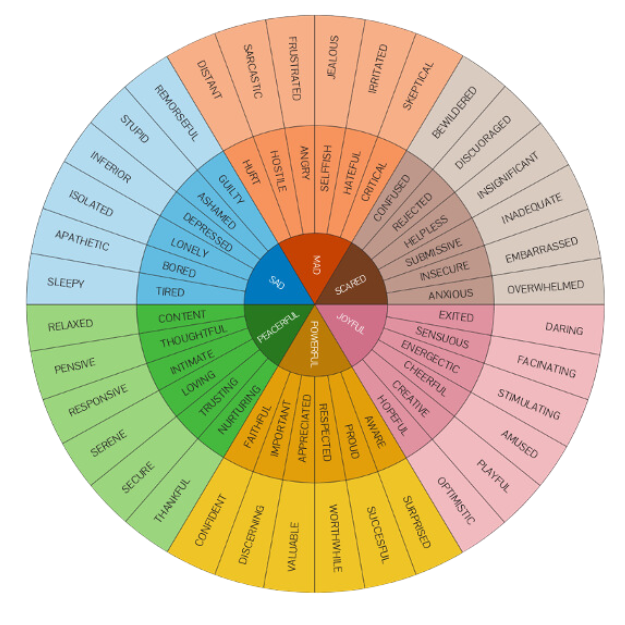The Butterfly Effect and Feelings
Written by Maria Palamara LPC, NCC, CCC, September 2023
In my counseling work, one of the topics that I often work with clients on is to improve their emotional vocabulary. The Feeling Wheel (developed by Gloria Wilcox) is one of the tools that I find useful for this. Discussion of how to use this tool suggests the idea of how a first interpretation of a statement can lead to related emotions that can amplify or counter the intention of the original statement.
For example, one caregiver might say to a partner who is traveling for business that their child was sick today. “It wasn’t easy juggling my job and caring for a sick kid, but I managed well enough.“ On hearing this, the other partner could take their emotions in either of two directions. A positive interpretation would be feeling gratitude for their equal partnership and knowing they can trust their partner. Starting with gratitude, that partner might then feel other emotions that could build on each other in the Peaceful section of the feeling wheel, like loving, trusting, relaxed, and even into other areas of the lower half of the feeling wheel that deals with positive emotions. They might feel more powerful because this increases their confidence in their ability to dedicate energy to their own career without worrying about things at home.
On the other hand, the partner might take this same objective statement and start to feel guilty because they are not there to handle things as usual. This can lead to a barrage of negative emotions such as fear for whether the child will be ok and if the spouse can manage it, resentment and anger towards the spouse for perceived complaining, and feelings of self-inadequacy for their inability to be the perfect parent and perfect professional. Emotions lingering in the top half of the feelings wheel can build on each other, contributing to sadness and low self-esteem.
In explaining this hypothetical progression of feelings, it brings me back to my engineering school days of learning about control systems. People have asked me how someone can change their career from a hard science like engineering to counseling. I have often said that systems are systems, whether it be electromechanical systems or human systems in the family or in a community of people. One thing affects everything else that it is connected to, and sometimes can lead to great things or terrible disasters. Initial conditions can start the system in motion.
With complicated and chaotic systems, there is a concept called the butterfly effect. The butterfly effect as a distinct effect is credited to Edward Lorenz (1917–2008), a meteorologist and mathematician who successfully combined the two to create chaos theory. Lorenz noted that the butterfly effect is derived from the metaphorical example of the details of a tornado (the exact time of formation, the exact path taken) being influenced by minor perturbations such as a distant butterfly flapping its wings several weeks earlier.
The discussion of the feelings wheel brought me around to thinking about and mentioning the butterfly effect in one of my sessions. In other words, we can choose our approach to interpreting statements by a loved one. Based on that first interpretation, it can either strengthen our love or drive division between us. The lesson is to take care to look at situations as clearly as possible, and if a positive interpretation is possible, choosing that interpretation will help us to cultivate gratitude and positive emotions, which will in turn make us a happier and healthier person and help our relationships thrive.
Resources:
Wilcox, Gloria, “The Feeling Wheel”: https://www.gnyha.org/wp-content/uploads/2020/05/The-Feeling-Wheel-Positive-Psycology-Program.pdf
The Butterfly Effect: Everything You Need to Know About This Powerful Mental Model: https://fs.blog/the-butterfly-effect/
Butterfly Effect: https://en.wikipedia.org/wiki/Butterfly_effect


